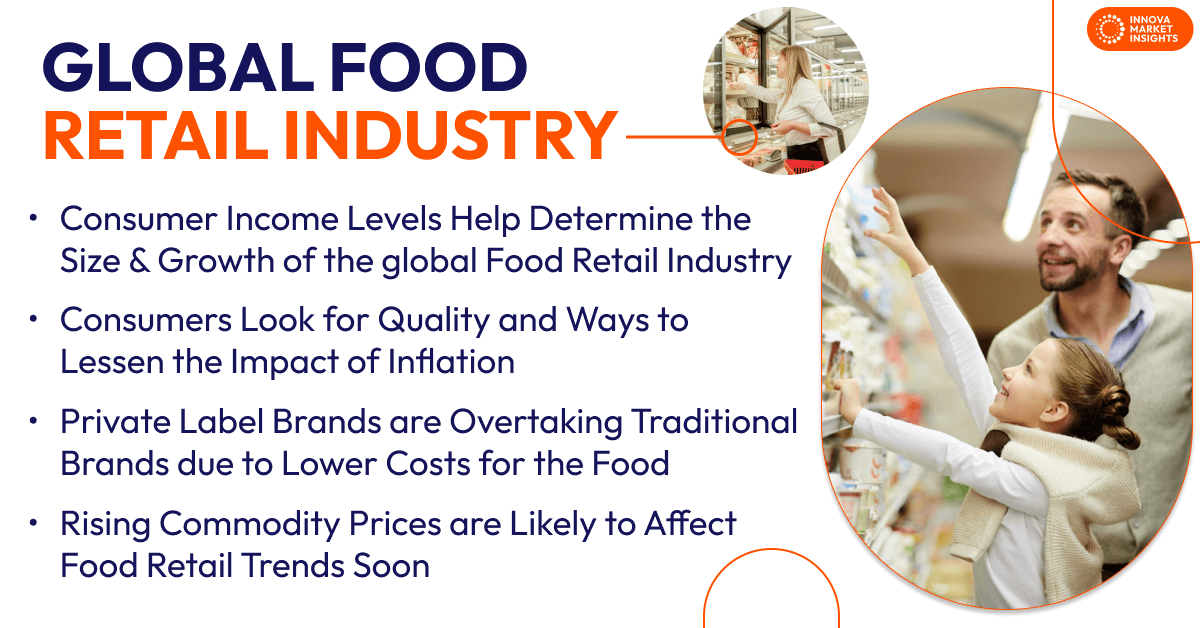December 6, 2024 – The food retail industry has changed tremendously in recent years and especially since the COVID-19 pandemic. The supply chain was disrupted and retail shopping habits changed. Overall, the lockdown due to COVID-19 helped supermarkets, and many were able to stay open during the pandemic and also build their capabilities for remote ordering. Today’s marketplace is different.
Food Retail Industry is Mature
In most countries with a large economy, the food retail industry is mature. Additionally, population and consumer income levels help determine the size and growth of the global food retail industry. The food retail industry is larger in countries with larger and wealthier populations. Sales globally are growing steadily but they lag behind the growth rate of general retail sales.
The US continues to experience overall economic growth and steady retail growth. However, foodservice sales have rebounded since the pandemic, taking away share from the food retail industry.
The food retail marketplace has undergone consolidation in recent years. Fewer food retailers and specialty outlets are in the market. Attempted mergers and acquisitions are being challenged by regulators because retail markets already are highly concentrated. Also, private label accounts for up to half of European and one-third of US grocery sales.
The past three years have changed the face of the food retail industry and more changes and challenges are expected.
Consumer Behavior Changes
Consumer behavior toward food retail trends changed during 2020-2021 and continues to evolve. Some behaviors are stable, such as shopping for grocery items in physical stores at least once a week. However, consumers are less willing to pay the additional cost of grocery delivery services.
In 2024, Innova Market Insights conducted its annual Foodservice and Grocery Shopping consumer trends research. It found that while a proportion of shoppers order groceries online at least once a week, a high proportion never do. Among those shopping for food at least once a week, three-quarters shop in a physical store, and one-third have groceries delivered to their home. Home food delivery usage is down among consumers.
Consumers look for quality and ways to lessen the impact of inflation. They shop at supermarkets, followed by specialty stores for higher-quality items and discounters for more economical options. Consumers also shop in person to choose their own products and assess the quality of what they buy.

Online Shopping Evolves
Online sales that rose during the pandemic years have fallen back and are a small proportion of total sales value. Consumers who shop online – frequent shoppers and those who shop online at least monthly – mention quality, convenience, and time saving. Those who shop online prefer the store’s app over a third-party app. Grocery retailers who offer online ordering and delivery face competition from both online retailers and direct delivery companies.
Dark stores that offer delivery or curbside pickup are not well-known. Consumers participating in consumer trends research say they don’t use dark stores, but they may not realize that their delivery is being fulfilled by a dark store.
Costs Affect Sales
Consumers are sensitive to cost. That partially explains why discounters and warehouses are competitors for global food retail industries. Private label brands are overtaking traditional brands because they sell foods at a lower cost. Food market retailers also face rising costs for property and delivery.
Inflation Takes a Bite
Rising food retail prices plus reduced economic activity and lower consumer incomes affect consumer shopping behaviors. A solid proportion of respondents to a consumer trends research report noticing shrinkflation. In European markets, food sales volume has remained steady or gone down although food sales values have risen because of prices that are noticeably higher than before the pandemic. Steady economic growth in the US is supporting food retail industry sales growth. It is likely that rising commodity prices will impact food retail prices in the near future.
Companies and Brands
Like the global food retail industry in general, food companies report that retail sales value is rising despite declines in retail sales volumes. This is due in part to food price inflation. Companies are investing in digitization and automation to support changes in the way that consumers shop. Most companies focus on their home territories but some food retail industries have stores around the world.
What’s Next in the Food Retail Industry?
Consumer behaviors changed during the COVID-19 pandemic, but many have not continued, including the use of technology for food shopping. Companies are rethinking their commitment to technology and AI because adoption is expensive. They also need to adjust their inventories to reduce shopping demands. Discounters will become popular during recessions because they meet basic consumer needs with lower prices, even though their selection is smaller. In a recession, discount shoppers may not need sophistication. Private label is expected to grow, especially as quality matches that of name brands.
This article is based on Innova’s The Global Food Retail Industry report. This report is available to purchase or with an Innova Reports subscription. Reach out to find out more